Thesis Chapters by Chukwudi S . Ekwezuo
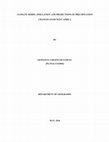
Changes in precipitation characteristics have been identified to exert profound socio-economic co... more Changes in precipitation characteristics have been identified to exert profound socio-economic consequences over West Africa. This study analysed climate model simulation and projections of precipitation changes over West Africa using the Norwegian Earth System Model (NorESM with Lat-Lon resolution of 1.89° by 2.5°). The skill of the model in reproducing the observed precipitation was evaluated for the present-day (1980-2005), its bias and relationship was determined using satellite derived precipitation data from Global Precipitation Climatology Project (GPCP). Using three possible future levels of atmospheric greenhouse gases concentration referred to as Representative Concentration Pathways (RCP) 2.6, 4.5 and 8.5, we calculated projected changes in mean precipitation for the early (2010-2035), mid (2040-2065) and late (2070-2095) twenty first century relative to the present-day period. The result of the analysis shows that precipitation decreases from the Guinea coast to the Sahel. The model also reproduced the general precipitation pattern with maximum and minimum precipitation of ~2600 mm and ~50 mm respectively. However, there are notable biases in southern Cameroun where precipitation is overestimated up to 90 mm and the Guinea-Sierra Leone coast where about 90 mm is underestimated. Despite this, there is a significant positive correlation between NorESM-simulation and GPCP-observed precipitation over the entire West Africa, Guinea Coast and the Sahel region at 0.98, 0.96 and 0.87 respectively. The projected changes in precipitation show that annual precipitation amount will increase over the Guinea coast and decreases further inland. Precipitation will intensify during June-July-August and September-October-November seasons in all RCPs. RCPs 8.5 and 4.5 projects intensification of precipitation over the Guinea coast and a slight increase over the Sahel. Late and mid twenty first century is projected to be wetter than the early and present day period. These patterns will likely cause flooding along shallow drainage basins and the coast especially in the mid twenty first century over the coast of Nigeria and Cameroun and most parts of West Africa. It will also lead to shift in the ecosystem which will affect agriculture and possibly change the distribution of disease vectors, cause water pollution and scarcity which will adversely affect the livelihood of the people in the region. Because of the importance of this projected pattern of precipitation changes, it is recommended that further studies be carried out to quantify the possible future impacts of precipitation changes over strategic sectors as well as posit mitigation and adaptation measures for the well being of the people.
Papers by Chukwudi S . Ekwezuo

Arabian Journal of Geosciences
The need for an effective method of prediction of the onset and cessation dates of the rainy seas... more The need for an effective method of prediction of the onset and cessation dates of the rainy season cannot be overstressed. It becomes more imperative considering that the mainstay of the economy of the tropical Guinea Savanna region and the country at large is agriculture that is still rain-fed. Thus, an effective prediction of the onset dates of the rainy season is the first step to ensure food security. Two efficient methods were developed—the hybrid and the modified Anyadike’s methods for the prediction of the onset dates of the rainy season and tested for the Guinea Savanna region of the country. Three stations were chosen: Lokoja, Bida and Jos. The methods proved to perform better than the earlier known and well-used method in the region—the Walter method. While the Walter method had about 12 false starts in Lokoja and 7 in Jos, the modified Anyadike had 5 and 3, respectively. However, the hybrid method had 1 and 2, respectively. The bias method also showed the hybrid method followed by the modified Anyadike’s methods outperformed the Walter and Anyadike’s methods. This is due to the overestimation associated with the Walter method and the underestimation by the Anyadike’s method. Therefore, the two developed methods are recommended for use in the agricultural planning for the Guinea savanna region of Nigeria and any other region with a similar climate. Thus, it is recommended to be applied to other tropical Guinea savanna regions.
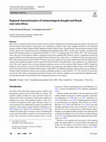
Sustainable Water Resources Management, Sep 10, 2020
West Africa is characterised by diverse hydro-climatic divisions ranging from the humid equatoria... more West Africa is characterised by diverse hydro-climatic divisions ranging from the humid equatorial climate to the semi-arid and arid climates that manifest in high space-time variability in rainfall. In this study, drought and floods in six delineated domains (Northern Sahel, Southern Sahel, Sudanian, Western Guinea Coast, Central Guinea Coast and Eastern Guinea Coast) of West Africa were illustrated using the Standardized Precipitation Index (SPI 3 months and 9 months) calculated from global CPC Merged Analysis of precipitation (CMAP 2.5° by 2.5° resolution) data from 1980 to 2017. The trend analysis shows that none of the domains exhibits a significant trend in the computed SPI. However, there is a significant trend in the annual rainfall rate for all the domains except the Eastern Guinea Coast. Again, there is a likelihood of an increasing trend of SPI-3 but a decreasing trend for the SPI-9. The drier areas have significant increasing rainfall trend while the highly humid regions show significant negative trend except for the Eastern Guinea Coast that shows a non-significant very weak positive trend. The most exposed area to extreme drought conditions occurs over the northern Sahel domain at SPI-3 though the frequency of occurrence is very low. The Western Guinea coast experiences the highest number of dry events of about 32% of the time followed by the Northern Sahel domain. Under SPI-9, the following domains: Eastern Guinea coast, Sudanian, Northern Sahel and Western Guinea coast are prone to flooding incidence as they had 40%, 37%, 29% and 26% of wet events, respectively. The study recommends apt and timely climate service delivery, adoption of ecosystem-based adaptation strategies that promote apt and sustainable water management practices in the region.
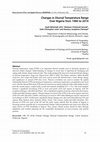
Dutse Journal of Pure and Applied Sciences, Jan 25, 2023
Diurnal temperature range (DTR) is an important derived variable used in detecting signature of o... more Diurnal temperature range (DTR) is an important derived variable used in detecting signature of observed climate changes. Understanding its changes in recent time is important for managing and coping with climate change induced risks. This study analysed the long term trend and abrupt changes in diurnal temperature range over Nigeria from 1960 to 2019. Descriptive statistics, Mann-Kendall trend test, Sen's slope and Pettit's tests were used to assess the characteristics, trend, abrupt change and significance in annual DTR time series. Pearson correlation was used to examine the spatial relationship between DTR and minimum temperature, maximum temperature, precipitation and cloud cover. Results showed that mean DTR amount varied across spatio-temporal scales with steady increase from the coastal region, coupled with a weak inter-annual variability (CV < 3%). The trend analysis showed a significant decreasing DTR in most grid points (GP) and regions of Nigeria, with the exception of Enugu, Ado-Ekiti and Warri. Also a significant negative trend was observed at the Guinea, Sudan and Sahel savanna regions. Abrupt changes occurred in the 1970s in the entire regions and most of the GPs with Ado-Ekiti, Calabar, and Enugu occurred in 1991 while Maiduguri and Jos experienced such changes in 2011. Furthermore, significant abrupt changes were observed at the following GPs and regions
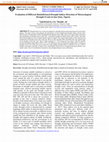
Journal of applied science and environmental management, May 22, 2020
Drought Indices are extensively adopted as a drought detection and monitoring tool in all climati... more Drought Indices are extensively adopted as a drought detection and monitoring tool in all climatic regions. This study assesses and compares the performance of four rainfall based drought indices, Deciles index (DI), Percent of Normal Index (PNI), Standardized Precipitation Index (SPI) and Z-score Index (ZSI) in detection and classification of drought events in Imo state , a humid environment of Nigeria from (1982 to 2016). The result shows that droughts do occur in humid climatic region of Nigeria. The various indices differ in their detection and classification of drought events in the study area. However, they classified 2007 and 2008 as the year with the most severe drought event in the state. There is high correlation (r > 0.70) among the four indices, with ZSI and PNI showing the highest relationship to SPI (r= 0.97). The differences observed among the drought indices in detecting drought events in the study area can be reduced by using multiple drought indices in addition to the use of SPI in drought assessments especially in Nigeria since technological advancement in drought monitoring software's has made it easier. Also it is worthwhile to research on why drought detection varies with indices.
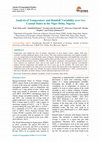
Annals of Geographical Studies
Temperature and rainfall has been of primary importance in most climate science studies. With the... more Temperature and rainfall has been of primary importance in most climate science studies. With their variability exerting significant impact on the Society. This study analysed temperature and rainfall variability over two coastal states in the Niger Delta region of Nigeria. Annual temperature and rainfall time series data from 1986 to 2016 for Uyo (AkwaIbom State) and Port Harcourt (Rivers State) respectively were the archive of the Nigeria Meteorological Agency (NIMET). The descriptive qualitative and quantitative method of time series analysis was employed, charts such as time graph to aid in the empirical analysis. Correlational analysis between temperature and rainfall was test to carry out on the variables. The result shows that temperature and rainfall in the study area are inversely related. This means that as the temperature increases, rainfall decreases in the study area. Though, the result is statistically insignificant (p > 0.05). Conclusively the data shows that effect of climate change is mainly affecting temperature in the area
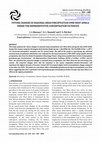
Nigerian Journal of Technology, Jan 17, 2018
This study analysed the future changes in seasonal-mean precipitation over West Africa during the... more This study analysed the future changes in seasonal-mean precipitation over West Africa during the mid (2040-2065) twenty first century using the Norwegian Earth System Model version 1 (NorESM1-M). The NorESM1-M has ~1.89° x 2.5° horizontal atmospheric resolution and 26 vertical levels. The skill of the model in reproducing the observed seasonal-mean precipitation distribution was evaluated for the historical period (1980-2005) using satellite derived precipitation data from the Global Precipitation Climatology Project. Using three possible future levels of atmospheric greenhouse gas concentrations-the Representative Concentration Pathways (RCPs) of 2.6Wm-2 , 4.5Wm-2 and 8.5 Wm-2 , we calculated the projected changes in seasonal-mean precipitation over West Africa for the mid-twenty first century. The projected changes show that the transition to dry season (September-October-November) will experience the highest amounts of increase. Overall, RCP 4.5 projects higher levels of precipitation change compared to the other two RCPs. This points to a non-linear effect of intensified greenhouse forcing on precipitation over West Africa; suggesting that after a particular level of greenhouse gas concentrations further increase may have little or no effect on the regions precipitation.
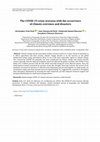
Central European Journal of Geography and Sustainable Development
Climate change and the associated weather extreme events are a major threat to humanity as it aff... more Climate change and the associated weather extreme events are a major threat to humanity as it affects agriculture and food security. Climate change disaster is on the increase as the global temperature keeps rising. Sub-Saharan Africa is one of the most vulnerable regions to climate change. The coronavirus (COVID-19) pandemic has been complicated by climate change and related extreme events especially with the imposed lockdown which has affected the global economy. The COVID-19 has killed over 4 million persons with the USA, Brazil and India being the worst affected nations. Thus, the multi-hazard scenario presented by extreme events like drought, flood and cyclones this period of the pandemic worsened its spread as it affected social distancing and personal hygiene as many people are crammed in camps and water become scarce for handwashing. It is suggested for countries to strengthen their emergency department by boosting the staff component, provide adequate technical support and ...
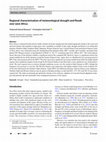
Sustainable Water Resources Management, 2020
West Africa is characterised by diverse hydro-climatic divisions ranging from the humid equatoria... more West Africa is characterised by diverse hydro-climatic divisions ranging from the humid equatorial climate to the semi-arid and arid climates that manifest in high space-time variability in rainfall. In this study, drought and floods in six delineated domains (Northern Sahel, Southern Sahel, Sudanian, Western Guinea Coast, Central Guinea Coast and Eastern Guinea Coast) of West Africa were illustrated using the Standardized Precipitation Index (SPI 3 months and 9 months) calculated from global CPC Merged Analysis of precipitation (CMAP 2.5° by 2.5° resolution) data from 1980 to 2017. The trend analysis shows that none of the domains exhibits a significant trend in the computed SPI. However, there is a significant trend in the annual rainfall rate for all the domains except the Eastern Guinea Coast. Again, there is a likelihood of an increasing trend of SPI-3 but a decreasing trend for the SPI-9. The drier areas have significant increasing rainfall trend while the highly humid regions show significant negative trend except for the Eastern Guinea Coast that shows a non-significant very weak positive trend. The most exposed area to extreme drought conditions occurs over the northern Sahel domain at SPI-3 though the frequency of occurrence is very low. The Western Guinea coast experiences the highest number of dry events of about 32% of the time followed by the Northern Sahel domain. Under SPI-9, the following domains: Eastern Guinea coast, Sudanian, Northern Sahel and Western Guinea coast are prone to flooding incidence as they had 40%, 37%, 29% and 26% of wet events, respectively. The study recommends apt and timely climate service delivery, adoption of ecosystem-based adaptation strategies that promote apt and sustainable water management practices in the region.
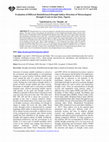
Journal of Applied Sciences and Environmental Management, 2020
Drought Indices are extensively adopted as a drought detection and monitoring tool in all climati... more Drought Indices are extensively adopted as a drought detection and monitoring tool in all climatic regions. This study assesses and compares the performance of four rainfall based drought indices, Deciles index (DI), Percent of Normal Index (PNI), Standardized Precipitation Index (SPI) and Z-score Index (ZSI) in detection and classification of drought events in Imo state , a humid environment of Nigeria from (1982 to 2016). The resultshows that droughts do occur in humid climatic region of Nigeria. The various indices differ in their detection and classification of drought events in the study area. However, they classified 2007 and 2008 as the year with the most severe drought event in the state. There is high correlation (r > 0.70) among the four indices, with ZSI and PNI showing the highest relationship to SPI (r= 0.97). The differences observed among the drought indices in detecting drought events in the study area can be reduced by using multiple drought indices in addition t...
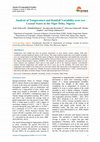
Annals of Geographical Studies, 2020
Temperature and rainfall has been of primary importance in most climate science studies. With the... more Temperature and rainfall has been of primary importance in most climate science studies. With their variability exerting significant impact on the Society. This study analysed temperature and rainfall variability
over two coastal states in the Niger Delta region of Nigeria. Annual temperature and rainfall time series data from 1986 to 2016 for Uyo (AkwaIbom State) and Port Harcourt (Rivers State) respectively were the archive of the Nigeria Meteorological Agency (NIMET). The descriptive qualitative and quantitative method of time series analysis was employed, charts such as time graph to aid in the empirical analysis. Correlational analysis between temperature and rainfall was test to carry out on the variables. The result shows that temperature and rainfall in the study area are inversely related. This means that as the temperature increases, rainfall decreases in the study area. Though, the result is statistically insignificant (p > 0.05). Conclusively the data shows that effect of climate change is mainly affecting temperature in the area.
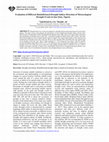
Journal of Applied Sciences and Environmental Management, 2020
Drought Indices are extensively adopted as a drought detection and monitoring tool in all climati... more Drought Indices are extensively adopted as a drought detection and monitoring tool in all climatic regions. This study assesses and compares the performance of four rainfall based drought indices, Deciles index (DI), Percent of Normal Index (PNI), Standardized Precipitation Index (SPI) and Z-score Index (ZSI) in detection and classification of drought events in Imo state , a humid environment of Nigeria from (1982 to 2016). The result shows that droughts do occur in humid climatic region of Nigeria. The various indices differ in their detection and classification of drought events in the study area. However, they classified 2007 and 2008 as the year with the most severe drought event in the state. There is high correlation (r > 0.70) among the four indices, with ZSI and PNI showing the highest relationship to SPI (r= 0.97). The differences observed among the drought indices in detecting drought events in the study area can be reduced by using multiple drought indices in addition to the use of SPI in drought assessments especially in Nigeria since technological advancement in drought monitoring software's has made it easier. Also it is worthwhile to research on why drought detection varies with indices.
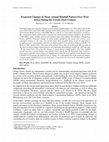
Pakistan Journal of Meteorology, 2017
This study analysed projected changes in mean annual rainfall pattern over West Africa during the... more This study analysed projected changes in mean annual rainfall pattern over West Africa during the early (2010-2035), mid (2040-2065) and late (2070-2095) twenty first century using the Norwegian Earth System Model version 1 (NorESM1-M) at ~1.89° X 2.5° horizontal atmospheric resolution. We evaluated the ability of the model to simulate the observed mean annual rainfall for the baseline (1980-2005), using satellite derived precipitation data from Global Precipitation Climatology Project (GPCP). Projected changes in mean annual rainfall for the twenty first century, were calculated relative to the base line period using three possible future levels of atmospheric greenhouse gases concentration referred to as Representative Concentration Pathways (RCPs) 2.6 Wm-2 , 4.5 Wm-2 and 8.5 Wm-2. The result of the analysis shows that, the model generally reproduced the observed mean annual rainfall pattern with maximum and minimum rainfall of ~2600 mm and ~50 mm respectively. The projected changes in mean annual rainfall pattern show that rainfall amount increases over the Guinea coast and decreases inland. Also the mid twenty first century, is projected to experience more changes in rainfall pattern than the early and late twenty first periods, with RCP 4.5 projecting the highest level of change. It is anticipated that if the projected changes in mean annual rainfall pattern occur in the future, it may lead to stress on water dependent sensitive sectors in the region.
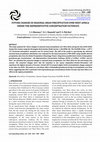
This study analysed the future changes in seasonal-mean precipitation over West Africa during the... more This study analysed the future changes in seasonal-mean precipitation over West Africa during the mid (2040-2065)
twenty first century using the Norwegian Earth System Model version 1 (NorESM1-M). The NorESM1-M has ~1.89° x
2.5° horizontal atmospheric resolution and 26 vertical levels. The skill of the model in reproducing the observed
seasonal-mean precipitation distribution was evaluated for the historical period (1980-2005) using satellite derived
precipitation data from the Global Precipitation Climatology Project. Using three possible future levels of atmospheric
greenhouse gas concentrations - the Representative Concentration Pathways (RCPs) of 2.6Wm-2, 4.5Wm-2 and 8.5
Wm-2, we calculated the projected changes in seasonal-mean precipitation over West Africa for the mid-twenty first
century. The projected changes show that the transition to dry season (September-October-November) will
experience the highest amounts of increase. Overall, RCP 4.5 projects higher levels of precipitation change compared
to the other two RCPs. This points to a non-linear effect of intensified greenhouse forcing on precipitation over West
Africa; suggesting that after a particular level of greenhouse gas concentrations further increase may have little or no
effect on the regions precipitation.











Uploads
Thesis Chapters by Chukwudi S . Ekwezuo
Papers by Chukwudi S . Ekwezuo
over two coastal states in the Niger Delta region of Nigeria. Annual temperature and rainfall time series data from 1986 to 2016 for Uyo (AkwaIbom State) and Port Harcourt (Rivers State) respectively were the archive of the Nigeria Meteorological Agency (NIMET). The descriptive qualitative and quantitative method of time series analysis was employed, charts such as time graph to aid in the empirical analysis. Correlational analysis between temperature and rainfall was test to carry out on the variables. The result shows that temperature and rainfall in the study area are inversely related. This means that as the temperature increases, rainfall decreases in the study area. Though, the result is statistically insignificant (p > 0.05). Conclusively the data shows that effect of climate change is mainly affecting temperature in the area.
twenty first century using the Norwegian Earth System Model version 1 (NorESM1-M). The NorESM1-M has ~1.89° x
2.5° horizontal atmospheric resolution and 26 vertical levels. The skill of the model in reproducing the observed
seasonal-mean precipitation distribution was evaluated for the historical period (1980-2005) using satellite derived
precipitation data from the Global Precipitation Climatology Project. Using three possible future levels of atmospheric
greenhouse gas concentrations - the Representative Concentration Pathways (RCPs) of 2.6Wm-2, 4.5Wm-2 and 8.5
Wm-2, we calculated the projected changes in seasonal-mean precipitation over West Africa for the mid-twenty first
century. The projected changes show that the transition to dry season (September-October-November) will
experience the highest amounts of increase. Overall, RCP 4.5 projects higher levels of precipitation change compared
to the other two RCPs. This points to a non-linear effect of intensified greenhouse forcing on precipitation over West
Africa; suggesting that after a particular level of greenhouse gas concentrations further increase may have little or no
effect on the regions precipitation.
over two coastal states in the Niger Delta region of Nigeria. Annual temperature and rainfall time series data from 1986 to 2016 for Uyo (AkwaIbom State) and Port Harcourt (Rivers State) respectively were the archive of the Nigeria Meteorological Agency (NIMET). The descriptive qualitative and quantitative method of time series analysis was employed, charts such as time graph to aid in the empirical analysis. Correlational analysis between temperature and rainfall was test to carry out on the variables. The result shows that temperature and rainfall in the study area are inversely related. This means that as the temperature increases, rainfall decreases in the study area. Though, the result is statistically insignificant (p > 0.05). Conclusively the data shows that effect of climate change is mainly affecting temperature in the area.
twenty first century using the Norwegian Earth System Model version 1 (NorESM1-M). The NorESM1-M has ~1.89° x
2.5° horizontal atmospheric resolution and 26 vertical levels. The skill of the model in reproducing the observed
seasonal-mean precipitation distribution was evaluated for the historical period (1980-2005) using satellite derived
precipitation data from the Global Precipitation Climatology Project. Using three possible future levels of atmospheric
greenhouse gas concentrations - the Representative Concentration Pathways (RCPs) of 2.6Wm-2, 4.5Wm-2 and 8.5
Wm-2, we calculated the projected changes in seasonal-mean precipitation over West Africa for the mid-twenty first
century. The projected changes show that the transition to dry season (September-October-November) will
experience the highest amounts of increase. Overall, RCP 4.5 projects higher levels of precipitation change compared
to the other two RCPs. This points to a non-linear effect of intensified greenhouse forcing on precipitation over West
Africa; suggesting that after a particular level of greenhouse gas concentrations further increase may have little or no
effect on the regions precipitation.